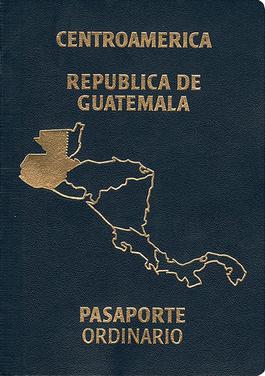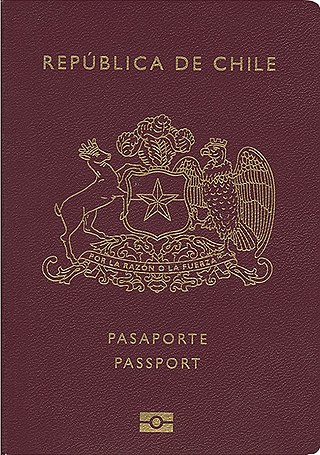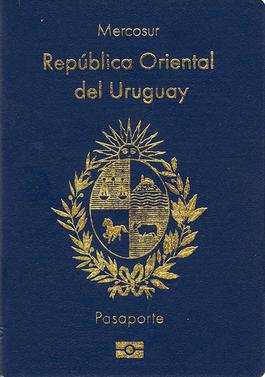
The Andean Community is a free trade area with the objective of creating a customs union comprising the South American countries of Bolivia, Colombia, Ecuador, and Peru. The trade bloc was called the Andean Pact until 1996 and came into existence when the Cartagena Agreement was signed in 1969. Its headquarters are in Lima, Peru.

A biometric passport is a traditional passport that has an embedded electronic microprocessor chip, which contains biometric information that can be used to authenticate the identity of the passport holder. It uses contactless smart card technology, including a microprocessor chip and antenna embedded in the front or back cover, or centre page, of the passport. The passport's critical information is printed on the data page of the passport, repeated on the machine readable lines and stored in the chip. Public key infrastructure (PKI) is used to authenticate the data stored electronically in the passport chip, supposedly making it expensive and difficult to forge when all security mechanisms are fully and correctly implemented.
The Andean passport is a passport for South American countries that are members of the Andean Community of Nations (ACN).

Argentine passport are issued to citizens of Argentina by the National Registry for People (ReNaPer). They were issued exclusively by the Argentine Federal Police up to 2011. Their primary use is to facilitate international travel.

The Mexican passport is the passport issued to Mexican citizens for the purpose of travelling abroad. The Mexican passport is also an official ID and proof of Mexican citizenship. According to the January 2024 Henley Visa Restrictions Index, holders of a Mexican passport can visit 161 countries without a visa, placing Mexico in the 23rd rank in terms of global travel freedom.

Venezuelan passports are issued to citizens of Venezuela to travel outside the country. Biometric passports have been issued since July 2007, with a RFID chip containing a picture and fingerprints; passports issued earlier remained valid until they expired.

A Panamanian passport is the passport issued to citizens of Panama to facilitate international travel. Panamanian citizens enjoy visa-free access to 118 countries and territories. The passports are issued by the Passports Authority of Panama.

The Colombian passport is a travel document which is issued to citizens of Colombia for the purpose of international travel. Since September 2015, a biometric passport has been issued, but the previously issued machine-readable passport can be used until its expiration date.

Paraguayan passports are issued to Paraguayan citizens for travel outside of Paraguay. For traveling to full and associated member states of Mercosur, Paraguayan citizens can also use their civil identity cards.

Guatemalan passports are issued to Guatemalan citizens to travel outside Guatemala. As of 1 February 2024, Guatemalan citizens had visa-free or visa on arrival access to 137 countries and territories, ranking the Guatemalan passport 38th in terms of travel freedom according to the Henley visa restrictions index.

Honduran passports are issued to Honduran citizens to travel outside Honduras.

A Chilean passport is an identity document issued to citizens of Chile to facilitate international travel. Chilean passports are valid for worldwide travel and facilitate the access to consular services whilst abroad. They are issued by the Registro Civil e Identificación.

A Uruguayan passport is an identity document issued to Uruguayan citizens to travel outside Uruguay. For traveling in Mercosur countries, as well as Chile and Bolivia, Uruguayan citizens may use their ID card.. For naturalised legal citizens, the nationality of origin will still apply as Uruguayan nationality law currently doesn't give nationality to naturalised citizens, which may mean a visa may still required when travelling. This challenge appears to arise from a literal interpretation from the ICAO 9303 part 3 manual, which in its Spanish translation, uses the word nationality rather than the original English version which refers to citizenship in the case of the country code that applies in the machine readable zone. Paragraph 7.1 of ICAO 9303 part 3 notes that an error to avoid is "MRZ citizenship incorrectly reports the country of birth rather than citizenship.". Uruguay's national identity authority uses country of birth in lieu of nationality for naturalised citizens, leading to error responses on migratory and airline legal identity checks.

The Bolivian passport is the official travel document issued to citizens of Bolivia by the Bolivian Government through its specially appointed office, Dirección General de Migración. The document can also be extended abroad via consulate representatives.

An Ecuadorian passport is an identity document issued to citizens of Ecuador for the purpose of international travel. It is issued by the Registro Civil, Identificación y Cedulación in Ecuador, and the Minister of Foreign Affair Embassies & Consulates abroad. The Ecuadorian passport is a type of Andean passport, allowing for free rights of movement and residence in any of the Andean Community members. The Ecuador passport is normally issued for 10 years and has the benefit of having "visa-free" status for Andean Community and Mercosur members nations, and several Centro America nations.

A Mexican visa is a document issued by the National Institute of Migration, dependent on the Secretariat of the Interior, with the stated goal of regulating and facilitating migratory flows into the country.
Visitors to Peru must obtain a visa from one of the Peruvian diplomatic missions unless they are citizens of one of the visa-exempt countries.
Visitors to Argentina must obtain a visa from one of the Argentine diplomatic missions unless they are citizens of one of the visa-exempt countries.

National identity cards are issued to their citizens by the governments of most Organization of American States (OAS) member states. The exceptions are Canada and the United States, although the latter issues a passport card which is a valid document in some countries.























